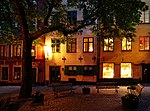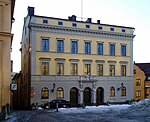Skeppar Olofs Gränd
Stockholm road stubsStreets in Stockholm

Skeppar Olofs Gränd (Swedish: "Alley of Skipper Olof") is an alley in Gamla stan, the old town in central Stockholm, Sweden. Stretching from Köpmangatan to Trädgårdsgatan, it forms a parallel street to Peder Fredags Gränd and Trädgårdstvärgränd.
Excerpt from the Wikipedia article Skeppar Olofs Gränd (License: CC BY-SA 3.0, Authors, Images).Skeppar Olofs Gränd
Skeppar Olofs Gränd, Stockholm Gamla stan (Södermalms stadsdelsområde)
Geographical coordinates (GPS) Address Nearby Places Show on map
Geographical coordinates (GPS)
| Latitude | Longitude |
|---|---|
| N 59.325277777778 ° | E 18.072638888889 ° |
Address
Skeppar Olofs Gränd 2
111 31 Stockholm, Gamla stan (Södermalms stadsdelsområde)
Sweden
Open on Google Maps










